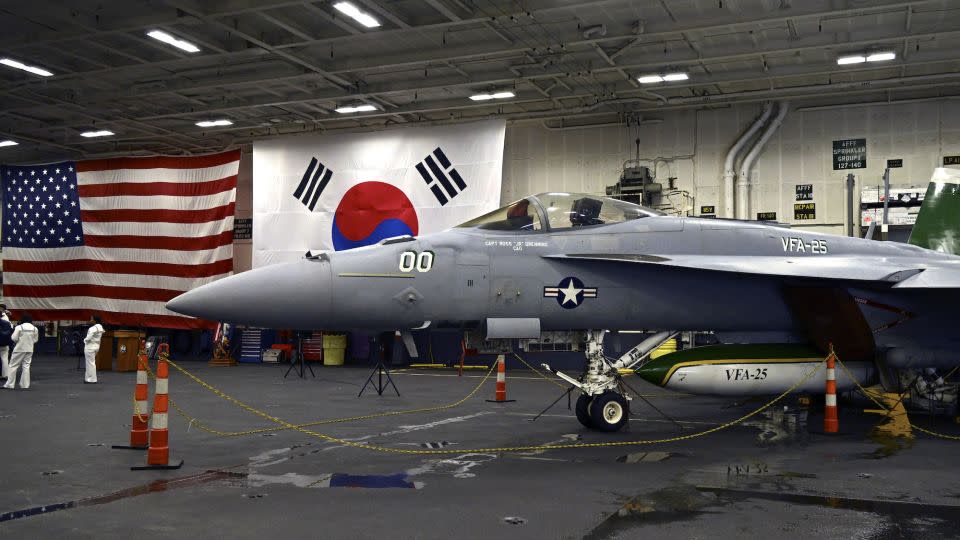US aircraft carrier arrives in South Korea as Russia-North Korea defense pact deepens regional fears

A United States Navy aircraft carrier has arrived in South Korea for a show of force as Washington, Seoul and Tokyo released a joint statement on Monday condemning deepening military ties between North Korea and Russia.
The nuclear-powered USS Theodore Roosevelt docked in the port of Busan on Saturday ahead of trilateral exercises with South Korea and Japan in the waters near the peninsula.
The Freedom Edge exercises resulted from an agreement made by the defense chiefs of the US, South Korea and Japan before Russian leader Vladimir Putin made his high-profile trip to Pyongyang last week. But the strongly worded joint statement the three partners released Monday shows the gravity with which they view a new “strategic partnership” between North Korea and Russia made during Putin’s trip.
Besides signing the defense deal with Kim Jong Un, Putin also linked security on the Korean Peninsula to Russia’s invasion of Ukraine, threatening to arm North Korea should South Korea provide military aid to Kyiv.
The US, South Korea and Japan “condemn in the strongest possible terms deepening military cooperation between the DPRK and Russia,” the joint statement said, using the acronym for the Democratic People’s Republic of Korea, North Korea’s official name.
Deepened ties between Moscow and Pyongyang, and the mutual defense pact “should be of grave concern to anyone with an interest in maintaining peace and stability on the Korean Peninsula, upholding the global non-proliferation regime, and supporting the people of Ukraine as they defend their freedom and independence against Russia’s brutal aggression,” it said.
The joint statement comes after all three partners separately expressed deep concerns over the treaty, including South Korea condemning it and summoning Russia’s ambassador on Friday, a rare diplomatic step that illustrates the soured tensions between Seoul and Moscow.
The aircraft carrier’s presence in Busan is just the latest in a series of US military moves to show Washington’s “ironclad” commitment to its own treaty ally in South Korea.
Earlier this month, US Air Force B-1B bombers participated in a live-fire exercise on the peninsula, the first time in seven years those long-range strike aircraft have dropped live munitions in South Korea.
And last week, a US Air Force AC-130 gunship also performed live-fire strikes on the same range where the B-1s dropped their bombs.
Joint drills with the US have long been a source of frustration and ire for North Korea which has pressed ahead with its illegal nuclear weapons program and missile testing under Kim, who has found a common cause with Putin.
Russia, which once supported sanctions on North Korea, used its veto power in the United Nations earlier this year to shield Pyongyang from further scrutiny and Putin has backed often backed Kim’s narrative.
“This confrontational policy on the part of the US to expand its military infrastructure in the subregion was accompanied by significant increases in the intensity and scale of military drills involving South Korea and Japan that are hostile towards North Korea,” Putin said in Pyongyang on Wednesday.
The visit of the USS Theodore Roosevelt to Busan marks the second time a Nimitz-class carrier has visited South Korea in seven months. The USS Carl Vinson called in Busan last November.
The Roosevelt, with some 5,000 personnel aboard, carries an air wing of more than 60 aircraft, including F/A-18 Super Hornet fighters.
The presence of the Roosevelt and its carrier strike group of supporting warships “demonstrates the solid combined defense posture and resolute will of the South Korea-US alliance to respond to the sophisticating threat from North Korea,” a statement from the South Korean military said.
Neither the US nor South Korea would give details or exact dates of the upcoming Freedom Edge exercise.
But the three have been working more closely together, including recent exercises involving forces from all three countries.
The Pentagon on Sunday gave a clue as to the timing of the Freedom Edge exercise, releasing a statement saying the Roosevelt would be departing the Indo-Pacific theater next week and heading to the Middle East to replace the carrier USS Dwight D. Eisenhower.
The Eisenhower left the region on Saturday after more than seven months of operations that included attacks on Houthi targets in Yemen to protect commercial shipping in the region from the Iran-backed group’s missiles and drones.
The movement of the Roosevelt from the western Pacific leaves temporarily only one US carrier in the region, the USS Ronald Reagan, which is homeported in Yokosuka, Japan.
CNN’s Yoonjung Seo contributed reporting.
For more CNN news and newsletters create an account at CNN.com


